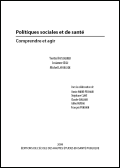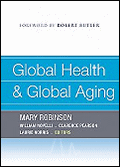LU POUR VOUS DE MAI 2008 : livres du mois - sites du mois - working papers
Tous les lu pour vous
LES LIVRES DU MOIS
La réforme des systèmes de santé.
Palier B.
Paris : Presses Universitaires de France : 2008 : 128 p.
Franchises, parcours de soin, limitation des arrêts de travail... Les gouvernements accumulent les mesures et pourtant le déficit de l'assurance maladie continue d'exister. Peut-on maîtriser l'augmentation des dépenses de santé ? Pourquoi ces dépenses augmentent-elles partout, et plus vite dans certains pays (Etats-Unis, France, Allemagne) que dans d'autres (Grande-Bretagne, Suède) ? Toutes les réformes des systèmes de santé doivent arbitrer entre quatre objectifs souvent contradictoires que cet ouvrage analyse : assurer la viabilité financière des systèmes, mais aussi l'égal accès aux soins, la qualité de ceux-ci, enfin la liberté et le confort des patients et des professionnels. Les dernières mesures décidées en France semblent abandonner progressivement l'idée d'une médecine de ville solidaire au profit des trois autres objectifs.
Traité de santé publique.
Bourdillon F., Brucker G., Tabuteau D., Kouchner B.
Paris : Médecine Sciences Flammarion : 2008 : 745 p.
Cet ouvrage réalisé par des spécialistes du domaine synthétise toutes les informations disponibles et actualisées sur la santé publique en France. Les thèmes abordés sont regroupés selon les problématiques suivantes : les grands enjeux de santé publique (droits des personnes, qualité des soins, sécurité sanitaire …) ; état de santé et principales pathologies ; questions de société (accidents, addictions, violence …) avec une approche par groupes de population : organisation de la santé publique. Cet ouvrage comprend aussi une définition et un historique de la santé publique en France.
Ma santé demain : 11 décideurs répondent.
Cardin H., Requillart H.
Paris : Editions Jacob-Duvernet : 2008/04 : 58-59
Hélène Cardin et Hervé Réquillart, journalistes spécialistes des questions de santé, sont allés à la rencontre de 11 décideurs, parmi lesquels Frédéric Van Roekeghem, directeur général de la Cnam, Didier Houssin, Directeur général de la santé ou encore Christian Saout, Président du Comité inter associatif sur la santé (CISS) en leur proposant de réagir aux recommandations des citoyens. En regroupant ces onze entretiens, l'ouvrage « Ma santé demain. 11 décideurs répondent » prolonge le dialogue entre décideurs, experts et citoyens. Il permet également de répondre à de nombreuses questions centrales comme celle de la prévention, de la qualité des soins, du risque en santé ou encore de la place du patient dans le système de soins. Il permet enfin de dessiner les grandes tendances en œuvre au sein de notre système de santé et de soins.
Politiques sociales et de santé. Comprendre et agir.
Rayssiguier Y., Jegu J., Laforcade M.
Rennes : Editions EHESP : 2008 : 491 p.
Les questions sanitaires et sociales passionnent autant la population que le législateur. Dans ce secteur, plus que dans tout autre, l'explosion normative et réglementaire a créé un enchevêtrement de politiques et d'acteurs d'une rare complexité. Il convenait donc de clarifier ce vaste ensemble en présentant les politiques sociales et de santé les plus récentes de manière thématique et sous une forme raisonnée. Les auteurs ont délibérément choisi de ne pas séparer action et réflexion afin de permettre un regard critique. Sont évoqués non seulement le contenu précis des politiques et des textes mais aussi leur genèse, leur environnement, le jeu des acteurs qui les animent, les valeurs qui les portent. L'action sanitaire et sociale ne peut se résumer en effet à la présentation du droit positif et des politiques publiques. Pour être comprise, elle suppose des références à la science politique, à la sociologie des acteurs, aux théories de la complexité ou à l'analyse systémique. Toute nouvelle loi tend à accréditer l'idée d'une rupture, alors qu'elle s'inscrit le plus souvent dans une problématique ancienne. Enfin, les auteurs ont choisi de traiter dans un même ouvrage des politiques sanitaires et sociales. Séparer les deux peut donner provisoirement l'illusion de la simplification. Mais cette disjonction ne résiste pas à l'analyse, tant les besoins de la population et le contenu des politiques relient de plus en plus étroitement les dimensions sanitaire et sociale (4e de couverture.)
L'exclusion.
Damon J.
Paris : Presses Universitaires de France : 2008 : 126 p.
Les politiques de lutte contre la pauvreté sont devenues lutte contre l'exclusion. Cela traduit une volonté de prendre en compte non seulement la pauvreté conçue comme une absence ou une faiblesse de revenus mais aussi l'isolement, le besoin ou encore la ségrégation. Cet ouvrage explique ce que signifie raisonner et agir en termes d'exclusion. Il décrit et évalue les politiques mises en place, enfin il invite à des politiques sociales plus rationnelles.
Activité physique : contextes et effets sur la santé.
Institut national de la santé et de la recherche médicale. (Inserm). Paris.
Le ministère de la Jeunesse, des Sports et de la Vie associative a sollicité l'Inserm pour la réalisation d'une expertise collective, à partir des connaissances scientifiques et médicales, concernant les effets sur la santé de l'activité physique et sportive en termes de bénéfices et de risques. Le dopage qui constitue un domaine d'investigation en tant que tel est exclu du cadre de l'expertise. La synthèse et les recommandations de cet ouvrage fait l'objet d'un autre volume.
Placing health : neighbourhood and renewal, health improvement and complexity.
Localiser la santé : effets de voisinage et de renouveau, amélioration de la santé et complexité.
Blackman T.
Bristol : the Policy Press : 2006 : 246 p.
Where people live matters to their health. Health improvement strategies often target where people live, but do they work? Placing Health tackles this question through an examination of England's Neighbourhood Renewal Strategy and its health targets.
Gender and health : the effects of constrained choices and social policies.
Sexe et santé : les effets des choix contraints et des politiques sociales.
Bird C.E., Rieker P.P.
Gender and Health is the first book to examine how men's and women's lives and their physiology contribute to differences in their health. In a thoughtful synthesis of diverse literatures, the authors demonstrate that modern societies' health problems ultimately involve a combination of policies, personal behavior, and choice. The book is designed for researchers, policymakers, and others who seek to understand how the choices of individuals, families, communities, and governments contribute to health. It can inform men and women at each of these levels how to better integrate health implications into their everyday decisions and actions.
Global health and global aging.
Robinson M., Novelli W., Pearson C., Norris L.
San Francisco : Jossey Bass : 2007 : 373 p.
The book covers the fundamentals of global aging and health and provides real-world models from countries and regions that offer the best practices in current approaches. Global Health and Global Aging presents information about leadership and governance challenges as well as insights about aging in different cultures and countries in all regions of the world. The book explores the factors that contribute to high rates of longevity and shows how countries including Denmark, France, Finland, Germany, Japan, The Netherlands, Spain, Sweden, the United Kingdom, and the United States contribute to the overall health of their populations. The book also outlines the challenges facing specific countries such as Russia, India and China that have rapidly aging populations.
LES SITES DU MOIS DE MAI
ADOSEN (Action et documentation santé pour l'éducation nationale)
http://www.adosen-sante.com/
Presentation
Association agréé par l'Education Nationale, l'ADOSEN développe des actions de prévention et d'éducation pour la santé en milieu scolaire. Ses missions s'articulent autour de trois axes :
- Réalisation et diffusion de documents : édition d'un journal trimestriel consacré à un thème majeur de santé publique ou un sujet essentiel pour l'éducation des enfants.
- Formation : organisation et animation de stages de formation en éducation à la santé auprès des membres de la communauté éducative ; mise en place de sessions de formation sur la prévention des conduites suicidaires des adolescents, de la maltraitance des enfants, de l'approche du risque chez les jeunes en situation de vulnérabilité...
- Actions particulières des sections départementales.
Son site propose des dossiers thématiques sur les principaux thèmes de santé publique, des interviews d'experts, la liste de ses publications, des quizzs pour tester ses connaissances en matière de santé publique.
CETAF (Centre Technique d'Appui et de Formation des centres d'examens de santé)
http://www.cetaf.asso.fr/
Presentation
Le CETAF, Centre Technique d'Appui et de Formation des Centres d'Examens de Santé a été créé en 1994 pour accompagner les Centres d'Examens de santé (CES) dans leurs missions d'examens de santé, d'éducation pour la santé et de recherche épidémiologique. Le site se décompose en six rubriques :
- Les fiches techniques sur les troubles à surveiller dans le cadre des examens périodiques de santé (intérêts en prévention, limites de référence selon l'âge et le sexe, pratique dans les CES, conseils d'éducation pour la santé).
- Les recherches en prévention (nouveaux résultats et recherches en cours sur l'évaluation des tests et procédures de prévention). Trois missions prioritaires sont mises en avant : risques post-professionnels, prévention des risques liés au vieillissement, la précarité et les inégalités de santé.
- Géographie de la santé : présentation des principaux indicateurs de santé sous forme de graphiques et de cartes. Les données reposent sur l'exploitation de 576 242 examens de santé effectués en 2004 dans le réseau des CES, dans les CES de France métropolitaine et de Guadeloupe.
- Les formations à l'usage du personnel des CES.
- L'actualité (veille documentaire et nouvelles éditions du Cetaf).
- Les publications du Cetaf.
CRESIF (Comité Régional d'Education pour la Santé d'Ile-de-France)
http://www.cresif.org/
Presentation
Créé en 1984, le Comité Régional d'Éducation pour la Santé d'Île-de-France (CRESIF) est une association loi 1901 qui a pour vocation de promouvoir et de développer l'éducation pour la santé en Île-de-France. Il est un centre ressource régional en matière de promotion de la santé en fournissant des services de formation, d'information, de conseil et d'évaluation. Son fonds documentaire est consultable sur http://www.prosante-if.org/index.php. La base de données comprend environ 2 850 références (ouvrages, rapports études, mémoires et outils pédagogiques). Son centre de documentation propose également des bulletins de veille thématique (alimentation, tabac, personnes âgées, précarité) auxquels il est possible de s'abonner.
Inpes (Institut national de prévention et d'éducation en santé)
http://www.inpes.sante.fr/
Presentation
L'Inpes mène des programmes de prévention et d'éducation pour la santé.
Il organise des campagnes de communication pour aider la population à choisir des modes de vie et des comportements qui préservent et améliorent la santé. Aussi, le site offre la possibilité de trouver tous ces supports d'information en consultant le catalogue (recherche libre ou par thème, population, supports). Une entrée par thème de santé publique (accidents, alcool, cancer, drogues, nutrition, éducation du patient, événement climatique etc…) liste les dernières campagnes d'information réalisées (contexte, objectifs, dispositif) ainsi que les documents Inpes correspondants. Des entrées spécifiques selon le public auquel s'adressent (grand public, professionnels, presse) les différents documents permettent de cibler la recherche.
Les sommaires des derniers numéros de la revue Santé de l'homme ainsi que le résumé des Baromètres santé sont disponibles.
Trois bases de données sont disponibles en ligne : références bibliographiques, organismes, concepts et définitions en santé. Elles sont interrogeables séparément ou simultanément.
Enfin, on y trouve aussi les coordonnées des Comités Départementaux d'Education pour la Santé.
UFSBD (Union française pour la santé bucco-dentaire)
http://www.ufsbd.fr/
Presentation
L'UFSBD a été créée en 1966 par la profession dentaire pour développer la prévention collective et individuelles des maladies bucco-dentaires. Elle est constituée de comités départementaux qui mène des actions de terrain.
Trois espaces structurent le site :
- Espace professionnel : il regroupe les propositions de formation continue pour les professionnels de la santé bucco-dentaire, une revue professionnelle disponible en ligne, des actes de colloques, ainsi qu'un espace commercial qui propose du matériel pédagogique.
- Espace grand public : il présente les actions de prévention menée par l'association ainsi que des informations de base (les maladies buccodentaires, les dents, les soins dentaires, et leurs coûts, le brossage chez l'enfant etc.)
- Espace presse : on y trouve dossiers et communiqués de presse.
Autres enquêtes de santé :
- Infodoc du GRPS Nord Pas-de-Calais
(http://infodoc.santenpdc.org/) - Réseau francophone international en promotion de la santé. (REFIPS)
(http://www.refips.org) - Union Internationale de Promotion de la Santé et d'Education pour la Santé (UIPES)
(http://www.iuhpe.org)
VU DE L'ETRANGER : QUELQUES WORKING PAPERS ANALYSES
Etat de santé
Fighting for Breath - A European Patient Perspective on Severe Asthma. 

Combattre pour le souffle : une perspective européenne pour les patients souffrant d'asthme sévère.
European Federation of Allergy and Airways Diseases Patients Association. (E.F.A.). Bruxelles. BEL
Bruxelles : European Federation of Allergy and Airways Diseases Patients Association : 2008 : 30 p.
This is the first report to communicate the experience of Europeans with severe asthma symptoms, by the patients. We hope that this report will encourage national governments and the EU to prioritise severe asthma and increase awareness and information among the public, patients and healthcare professionals.
Heterogeneity, State Dependence and Health. 

Hétérogénéité, état de dépendance et santé.
Halliday T.J.
Bonn : The Institute for the Study of Labor : 2008/04 : 56 p.
We investigate the evolution of health over the life-cycle. We allow for two sources of persistence : unobserved heterogeneity and state dependence. Estimation indicates that there is a large degree of heterogeneity. For half the population, there are modest degrees of state dependence. For the other half of the population, the degree of state dependence is near unity. However, this may be the result of a high frequency of people in our data who never exit healthy states, potentially resulting in a failure to pin down the state dependence parameter for this segment of the population. We conclude that individual characteristics that trace back to early adulthood and before can have far reaching effects on health.
Hôpital
Health-care-associates infections in hospitals : Leadership Needed from HHS to Prioritize Prevention Practices and Improve Data on These Infections. 

Les infections nosocomiales à l'hôpital : leadership nécessaire au Department of Health and Human Services (HHS) dans le choix des priorités des pratiques de prévention et dans l'amélioration des données sur ces infections.
Steinwald B.A.
Washington : GAO : 2007/06 : 78 p.
According to the Centers for Disease Control and Prevention (CDC), health-care-associated infections (HAI) are estimated to be 1 of the top 10 causes of death in the United States. HAIs are infections that patients acquire while receiving treatment for other conditions. GAO was asked to examine (1) CDC's guidelines for hospitals to reduce or prevent HAIs and what the Department of Health and Human Services (HHS) does to promote their implementation, (2) Centers for Medicare & Medicaid Services' (CMS) and hospital accrediting organizations' required standards for hospitals to reduce or prevent HAIs and how compliance is assessed, and (3) HHS programs that collect data related to HAIs and integration of the data across HHS. GAO reviewed documents and interviewed officials from CDC, CMS, the Agency for Healthcare Research and Quality (AHRQ), and accrediting organizations.
Inégalités sociales
Social capital in the North East : how do we measure up ? 

Capital social dans le Nord-Est du Royaume-Uni : comment le mesurer ?
Schmuecker K.
Newcastle : Northern Rock Foundation : 2008/04 : 56 p.
This report assess the type and level of social capital in the North East region. This research takes the first steps in doing this.There are three common hypotheses we seek to test: the North East is a place of particularly strong communities; the North East is exceptional in terms of being a sociable place; the region has a culture of informal volunteering and social support,so using formal volunteering as a measure of social capital and active communities disadvantages the region. This paper provides a regional analysis of social capital, drawing on the General Household Survey (GHS) 2004/0
Médicaments
The Effect of Medicare Part D on Pharmaceutical Prices and Utilization 

Les effets du Medicare Part D sur les prix et consommation de médicaments.
Duggan M., Scott Morton F.
Cambridge : NBER : 2008/04 : 37 p.
On January 1, 2006, the federal government began providing insurance coverage for Medicare recipients' prescription drug expenditures through a new program known as Medicare Part D. Rather than setting pharmaceutical prices itself, the government contracted with private insurance plans to provide this coverage. Enrollment in Part D was voluntary, with each Medicare recipient allowed to choose from one of the private insurers with a contract to offer coverage in her geographic region. This paper evaluates the effect of this program on the price and utilization of pharmaceutical treatments. Theoretically, it is ambiguous whether the expansion in insurance coverage would increase or reduce pharmaceutical prices. Insurance-induced reductions in demand elasticities would predict an increase in pharmaceutical firms' optimal prices. However, Part D plans could potentially negotiate price discounts through their ability to influence the market share of specific treatments. Using data on product-specific prices and quantities sold in each year in the U.S., our findings indicate that Part D substantially lowered the average price and increased the total utilization of prescription drugs by Medicare recipients. Our results further suggest that the magnitude of these average effects varies across drugs as predicted by economic theory.
Politique de santé
State Health Policies Aimed at Promoting Excellent Systems: A Report on States' Roles in Health Systems Performance. 

Les politiques de santé régionales destinées à promouvoir des systèmes d'excellence : un rapport sur les rôles des Etats dans la performance des systèmes de santé.
Hess C., Schwartz S., Rosenthal J., Snyder A., Weil A.
Portland : National Academy for State Health Policy. : 2008 : 91 p.
This report presents findings from the State Health Policies Aimed at Promoting Excellent Systems (SHAPES) project undertaken by the National Academy for State Health Policy. The project built on the work of the Commonwealth Fund's Commission on a High Performance Health System to explore the roles that States play in influencing key health system components such as insurance coverage, quality of care, and information and provider infrastructures. After conducting surveys of multiple agencies in states across the country, as well as reviewing related literature, the authors found that states are pursuing system improvements across the full spectrum of their authority, including health care purchasing, regulation of providers, reporting of performance data, integration of public health with health care approaches, and improving the availability and affordability of health insurance. Despite this activity, this study finds room for states to do much more. The report also concludes that ongoing efforts to track, study and diffuse information on state activities could accelerate adoption of promising polices and practices.
Working for a healthier tomorrow. 

Travailler pour une meilleure santé demain.
Black C.
London : The Stationery Office (TSO) : 2008 : 125 p.
The subject of this review is the health of people of working age, individuals whose health has consequences often far beyond themselves – touching their families and children, workplaces and wider communities. The economic costs of ill-health and its impact on work are measurable and set out for the first time in this review; but the human costs are often hidden and privately borne. This Review has sought to establish the foundations for a broad consensus around a new vision for health and work in Britain. At the heart of this vision are three principal objectives: prevention of illness and promotion of health and well-being; early intervention for those who develop a health condition; and an improvement in the health of those out of work – so that everyone with the potential to work has the support they need to do so. Successive chapters of this report will set out proposals for realising these objectives.
Soins de santé primaires
Determinants of general pratictioners' wages in England. 

Déterminants des salaires des médecins généralistes en Angleterre.
Morris S., Sutton M., Gravelle H., Elliott B., Hole A., Ma A., Sibbald B., Skatun D.
York : University of York : 2008/05 : 17 p.
We analyse the determinants of annual net income and wages (annual net income/hours) of general practitioners (GPs) using a unique, anonymised, non-disclosive dataset derived from tax returns for 21,657 GPs in England for the financial year 2002/3. The average GP had a gross income of £189,300, incurred expenses of £115,600, and earned an annual net income of £73,700. The mean wage was £35 per hour. Net income and wages depended on gender, experience, list size, partnership size, whether or not the GP worked in a dispensing practice, whether or not they worked in a Primary Medical Service (PMS) practice, and the characteristics of the local population (limiting long term illness rate, proportion from ethnic minorities, population density, Index of Multiple Deprivation 2000). The findings have implications for discrimination by GP gender and country of qualification, economies of scale by practice size, incentives for competition for patients, compensating differentials for local population characteristics, and the attractiveness of PMS versus General Medical Services contracts.
Health care deprivation profiles in the measurement of inequality and inequity: an application to GP fundholding in the English NHS. 

Les profils de non recours aux soins dans la mesure de l'inégalité et de l'inéquité : une application au fundholding de médecins généralistes dans le système de santé anglais.
Laudicella M., Cookson R., Jones A.M., Rice N.
University of York. Health - Econometrics and Data Group. (H.E.D.G.). York. GBR.
This paper proposes a new approach to the measurement of inequality and inequity in the delivery of health care based on contributions from the literature on poverty and deprivation. This approach has some appealing characteristics: 1) inequity is additively decomposable by population subgroups; 2) the approach does not rely on socio-economic ranks; 3) it provides a graphical representation of the distribution of inequity; 4) it offers a range of indices consistent with dominance. An empirical application is provided investigating the effect of the GP fundholding reform on equity in English NHS. The results show that the most equitable GP practices self-selected into the scheme in 1991; evidence of an inequity-reducing treatment effect as well as a selfselection effect are found in 1992 and 1993; the self-selection process reduces and no evidence of a treatment effect is present thereafter.
Supplier Inducement in the Belgian Primary Care Market. 

Offre induite sur le marché belge des soins primaires.
Schaumans C.
Lewen : Catholic University of Leuven : 2007/07 : 39 p.
We address the presence of supplier-induced demand in the Belgian primary care market, which is characterized by a fixed fee system and a high density of General Practitioners (GP). Using a unique dataset on the number of visits of all Belgian GPs, we first investigate whether we can find evidence of demand inducement by Belgian GPs. Novel to this literature is that we furthermore investigate which type of visits GPs typically use for inducing demand. We extend the theoretical framework of Carlsen and Grytten (1998) to allow for a limitation in the possibility of inducing demand due to the amount of information in the market. As a result, our model predicts GPs to induce demand when the level of competition becomes high, while a further increase of competition triggers a decrease in their inducing behavior. The results indicate the presence of both availability effects and supplier inducement in the Belgian primary care market. We also find that GPs prefer the use of home visits during working hours to induce demand for their services. However, when competition gets fierce, they substitute toward inducement through office visits.
Copayments for Ambulatory Care in Germany : A Natural Experiment Using a Difference-in-Difference Approach. 

Schreyogg J., Grabka M.M.
German Institute for Economic Research. (D.I.W.). Berlin. DEU
In response to increasing health expenditures and a high number of physician visits, the German government introduced a copayment for ambulatory care in 2004 for individuals with statutory health insurance (SHI). Because persons with private insurance were exempt from the copayments, this health care reform can be regarded as a natural experiment. We used a difference-in-difference approach to examine whether the new copayment effectively reduced the overall demand for physician visits and to explore whether it acted as a deterrent to vulnerable groups, such as those with low income or chronic conditions. We found that there was no significant reduction in the number of physician visits among SHI members compared to our control group. At the same time, we did not observe a deterrent effect among vulnerable individuals. Thus, the copayment has failed to reduce the demand for physician visits. It is likely that this result is due to the design of the copayment scheme, as the copayment is low and is paid only for the first physician visit per quarter.
Physician organization in relation to quality and efficiency of care : a synthesis of recent literature. 

L'organisation des médecins en relation avec la qualité et l'efficience des soins ; une synthèse de la littérature récente.
Tollen L.
New York : The Commonwealth Fund : 2008/04 : 30 p.
Health care providers, researchers, policymakers, and the public have a growing recognition that today's health care delivery system is not organized to take advantage of the many drivers of quality and efficiency, and that the system suffers from underuse, overuse, and misuse of care. Many experts believe that greater (and different) delivery system organization is fundamental to improved quality and efficiency. This report summarizes and presents a framework for understanding recent research literature linking delivery system organizational attributes with health care efficiency and quality. The focus is on physician groups, as physicians represent the core of any organized delivery system. The report also highlights areas for further research and refinement of the framework and discusses whether and how policymakers can promote specific physician group attributes as a means of improving value.
Soins de longue durée
Long-term care in the European Union. 

Les soins de longue durée au sein de l'Union Européenne.
Commission Européenne. (C.E.). Direction Générale de l'Emploi - des Affaires Sociales et de l'Egalité des Chances. Bruxelles. BEL.
Bruxelles : Communauté européenne : 2007/11 : 34 p.
Ce rapport analyse les principaux problèmes auxquels les États membres sont confrontés en matière de soins de longue durée ainsi que les stratégies qu'ils ont adoptées pour les résoudre, et présente des solutions envisageables. Il se fonde sur les rapports nationaux élaborés dans le contexte du dispositif mis en place par l'Union pour la fixation d'objectifs, l'évaluation et l'élaboration de rapports en commun dans le domaine de la protection et de l'inclusion sociales – plus connu sous le nom de «méthode ouverte de coordination». Selon le rapport, les gouvernements nationaux font principalement face aux défis suivants : garantir l'accès de tous aux soins de longue durée, assurer le financement des soins de longue durée grâce à une combinaison judicieuse de ressources publiques et privées et à d'éventuelles modifications des mécanismes de financement, améliorer la coordination entre les services sociaux et médicaux, qui interviennent souvent dans la prestation de soins de longue durée, encourager le développement des soins à domicile ou de proximité au lieu des soins en institution, afin de permettre aux personnes dépendantes de rester chez elles aussi longtemps que possible, améliorer les modalités de recrutement et les conditions de travail des prestataires de soins formels et soutenir les prestataires de soins informels.
Health and long-term care in the European Union. Special Eurobarometer. 

Eurobaromètre spécial sur la santé et les soins de longue durée.
Commission Européenne. (C.E.). Direction Générale de l'Emploi - des Affaires Sociales et de l'Egalité des Chances. Bruxelles. BEL
Bruxelles : Communauté européenne : 2007/11 : 127 p.
This report studies successively the following issues covered by the survey. First of all, we focus on the lifestyle of Europeans, their health-limitations and their views about becoming dependent upon the help of others. In chapter two we examine the public's assessment of the health-care system in general and the care of dependent people specifically by looking at quality, availability, accessibility and affordability of health care services. We furthermore analyse the extent to which people have had to do without care because of availability, accessibility or affordability problems. The second part of the report focuses on attitudes to care of elderly and dependent people: how people want their elderly parents to be looked after, how should the care of elderly and dependent people be financed and how well elderly and dependent people are perceived to be looked after. In the final part we focus specifically on long-term care and the care of the elderly. We firstly examine Europeans' views about the provision of long term care: the appropriateness and costs and to what extent they themselves have been involved in providing care. We then look at people's views about receiving care: the perceived likelihood that people will receive appropriate care in the future, how they expect and prefer to be taken care of should the need arise and how they think they will finance their future long-term care. In the last chapter, we look at the extent to which abuse of elderly dependent people is perceived to be taking place, what forms of abuse this vulnerable group is subjected to and who the perpetrators are perceived to be.













